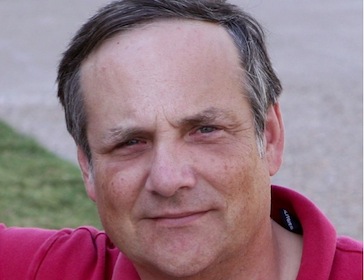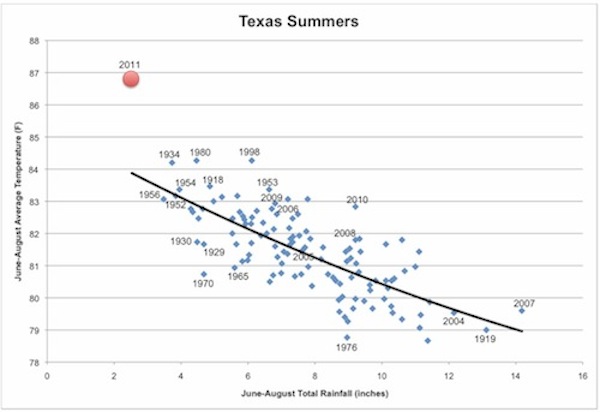Texas recently finished the hottest June-August summer in recorded U.S. history. The state’s drought, its worst one-year dry spell in recorded history, drags on and on.
The Texas state climatologist, John Nielsen-Gammon of Texas A&M University, has been saying for some time now that a La Niña weather pattern is the main reason for the drought, but that man-made global warming has made it more severe – just as it will aggravate future droughts.
Here’s how he expressed that judgement in August to Texas Climate News:
It’s clear … that when Texas is in a drought, global warming will make it worse. Higher temperatures lead to more evaporation during a drought, more rapid drying of the soil, and perhaps a stronger feedback loop whereby the dry weather prevents thunderstorms and perpetuates the drought during the summer. At the same time, more evaporation and more population means greater water demand and larger reductions in streamflow and inflow to reservoirs. So global warming has already amplified the impacts of the current drought.
Now, Nielsen-Gammon, named as state climatologist by then-Gov. George W. Bush, has elaborated on that conclusion in considerable technical detail on his Houston Chronicle-hosted blog, Climate Abyss.
Describing this detailed discussion as “preliminary,” Nielsen-Gammon said he has concluded that human-caused warming attributed to increasing emissions of greenhouse gases accounted for about a half-degree F – just shy of a tenth – of the extra heat Texas experienced from June through August.
Texas’ average temperature this summer, defined as the June-August period, was 86.8 degrees F. That was 5.4 F higher than the state’s “longterm average” summer temperature (from 1895-2011) of 81.4 F.
About 9 percent of this summer’s extra heat (that is, about 0.5 degree of the 5.4 degrees F in extra heat) was caused by increasing greenhouse gas emissions, while about 74 percent of the excess (4.0 F) resulted from the drought itself, Nielsen-Gammon calculated. He stressed that his calculations produced only rough estimates.
Explaining the findings about the human contribution, he told TCN by email: “The summer would have been about a half-degree F above average without greenhouse gases, but since greenhouse gases have contributed to the average value [since 1895], the total contribution is more like a degree.”
This is how he summarized his estimates on his blog:
Precipitation: The balance of evidence does not support the assertion that the rainfall deficit since October 2010 was made larger or more likely by global warming.
Temperature: Compared to long-term averages of summer temperature, the rainfall deficit accounted for about 4 [degrees] F of excess heat and global warming accounted for about 1 F of excess heat. Warmer temperatures lead to greater water demand, faster evaporation, and greater drying-out of potential fuels for fire. Thus, the impacts of the drought were enhanced by global warming, much of which has been caused by man.
As to whether the human influence via greenhouse gas emissions this year is “important or minor,” he wrote that “Texas would probably have broken the all-time record for summer temperatures this year even without global warming,” and that without it, the drought “to the best of my knowledge … would have been an outlier and a record-setter.”
Still, he added, man-made warming did have effects:
Regarding drought impacts, does an extra degree or degree and a half matter? No question it made it a bit more unpleasant. For farmers and ranchers, it made it a little bit harder for plants to survive, it made soils dry out faster, and it made stock tanks dry up much quicker because cattle needed more water at the same time water was evaporating from the tanks at a faster rate. The same applies to reservoirs: greater heat means less water making it all the way to the reservoir, water evaporating faster from the reservoir, and greater demands for water from the reservoir.
For wildfire, it made the grasses and trees a bit drier and killed more trees than would otherwise have died. It thus made fires more likely to start and allowed them to spread more rapidly. Presumably some fires would not have started at all, but we have no way of knowing which ones.
There are numerous other impacts too. For some impacts, the extra degree or more so of heat would have had little effect. For other impacts, the extra degree might have pushed things beyond their limit.
For most people the extra degree or degree and a half so was no big deal. For the rancher who’s managed to hang on until September but whose stock tank is going to run dry just a week or so before it would have been replenished by rain, or for the family whose house was just on the wrong side of the edge of the wildfire, a degree or degree and a half makes all the difference in the world.
Looking to the past and the future, he observed:
If a stable climate is desirable, which seems to be the prevailing consensus, global warming on Texas had a net beneficial effect in the 20th century, by counteracting cooling from other mechanisms. However, none of the viable cooling mechanisms are sustainable, so warmer temperatures in Texas are extremely likely in the future, and based on temperatures in the first eleven years of the 21st century, those days are already here.
Explaining his reason for offering a lengthy analysis of global warming’s influence on the Texas heat and drought, Nielsen-Gammon offered this context:
The question about the role of global warming in the Texas drought is properly addressed through careful modeling studies and corroborated with observations. Such studies take time. Meanwhile, there is strong and immediate interest in the role of global warming in the Texas drought, both because it’s the most extreme climate event currently taking place in the United States and because the Texas governor would have large influence over climate policy in the United States if his presidential candidacy is successful.
Gov. Rick Perry last week doubled down on his attacks on the huge majority of climate scientists (such as Nielsen-Gammon and all of his colleagues on A&M’s atmospheric sciences faculty) who endorse the consensus view that overwhelming evidence indicates human beings are warming and otherwise altering the earth’s climate system.
In a debate of Republican presidential contenders, Perry compared himself and others who disagree with that conclusion, which is also based on evidence from numerous other scientific fields, to the towering Italian Renaissance figure generally regarded as the founder of modern science:
The science is not settled on this [the question of man-made climate change]. The idea that we would put Americans’ economy at jeopardy based on scientific theory that’s not settled yet to me is just nonsense. Just because you have a group of scientists who stood up and said here is the fact. Galileo got outvoted for a spell.
Perry did not say, though others were quick to note, that the people “outvoting” and persecuting Galileo for saying correctly that the earth traveled around the sun were not other scientists but high-ranking clerics of the Roman Catholic Church.
For example, the editorial board of the Los Angeles Times offered this history lesson:
It would be far more accurate to compare Perry to Pope Urban VIII, who put Galileo on trial for heresy in 1633 because his conclusions that the earth revolved around the sun contradicted Scripture. All scientific theories have doubters, but what is remarkable about climate science is the degree of certainty and agreement among researchers. … At this point, the empirical evidence for warming, like the evidence for a heliocentric solar system or for evolution, is so strong that denial reflects a faith-based approach to public policy.
– Bill Dawson


